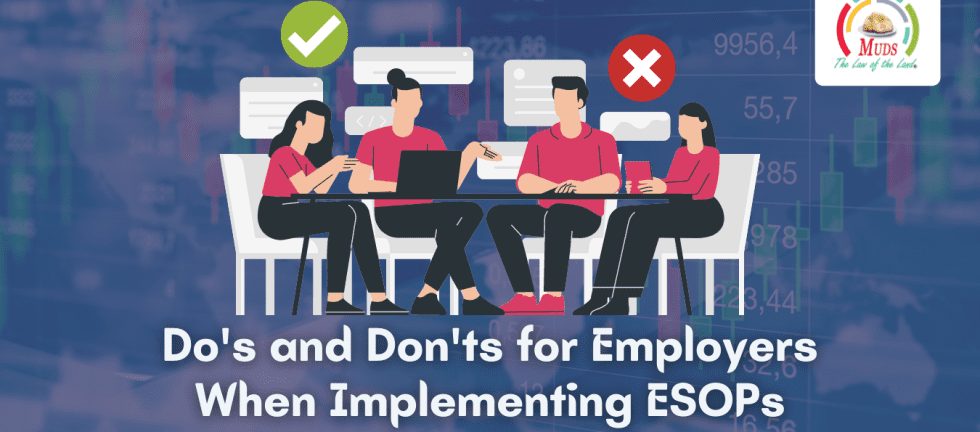Do’s and Don’ts for Employers When Implementing ESOPs
Stock options, or ESOPs in general, are a very successful strategy for retaining critical personnel in the Company’s ecosystem. It not only benefits the employee in creating wealth for himself, but it also aids in matching the employee’s particular aspirations with the Company’s general aim. Having said that, it is critical to remember the do’s and don’ts while creating a Stock Option Program.
The Stock Option, like any coin, has two sides and might fail if the Company does not implement the programme carefully. The following are some dos and don’ts for the Company in terms of Stock Option Programs.
Do’s for a Stock Option Program
1. Thought through Program:
ESOPs are a long-term investment tool. It is a reward mechanism, and once implemented, it is difficult to remove or significantly alter. This necessitates rigorous planning prior to its implementation. Aspects such as objectives anticipated to be attained, long-term dilution appetite, and staff coverage extent must be considered.
2. Understand the Industry Best Practices and Market Trends:
Stock options have now become an essential component of pay, particularly at the executive level. Since the usage of ESOPs has grown in the last several decades, there is a wealth of data available on option structures, terms, and their influence on corporate objectives. It is critical to grasp the current techniques and experience in this area.
3. Effective Employee Communication:
The employee should fully comprehend the parameters of the alternatives offered to them. It is critical that they have a thorough grasp of the Scheme’s regulations as well as the conditions of their particular awards. While customers should have a feel of what wealth creation may happen for them if they connect with the Company’s purpose, they should also understand that not every year and not every Grant will be a money spinner — firms go through ups and downs in the natural course of business.
It is also critical to ensure that the Grant documentation is valid and appropriate. Appointment letters and side letters should avoid ambiguous phrasing.
Periodic communication of the Company’s financial and operational success is also a useful habit to follow in order to foster a sense of belonging.
4. Revisit the program at regular intervals
The Company should review the plans on a regular basis to verify that they are in accordance with the Management Objectives, applicable laws and rules, and industry practises. Typically, shareholder approvals allow for considerable leeway in tweaking the conditions to better match with business reality.
Don’ts for a Stock Option Program
1. Ad hoc practices
An ad hoc stock option programme should never be implemented by the company. These programmes should ideally be tailored to the needs of the company and the goals it wishes to achieve. To design the correct programme, it is critical to understand the Company’s legal structure, business strategies, pay policy, and industry standards.
Ad hoc policy changes, such as introducing and removing personnel categories, abruptly modifying terms, and so on, should be avoided.
2. Commitment to Employees without having a Scheme
Employees should not be committed by the company before the Scheme is implemented. For example, the award amount for a specific employee will be determined by the instrument chosen (ESOPs / RSUs / SARs) as well as the expected wealth generation for that employee. Making a promise without establishing the framework and having a strategy in place may not provide the Company with the freedom that it should have given the limits.
The Management should not issue award letters until the Shareholders have approved the formation of the desired ESOP Pool and the implementation of the proposed Scheme. This action is null and invalid in the perspective of the law since it is void from the start.
3. Committing wealth creation
The benefits of options are totally dependent on the increase in the firm valuation. Aside from company success, value is also affected by a number of external factors. Companies, whether formally or informally, should avoid calculating and committing to value appreciation. Employees, on the other hand, should be made aware of the possibility of delayed and uncertain returns while the advantages are communicated.
4. Mention of ESOPs in Appointment letters or employment contracts
ESOPs are entirely optional. They are not a salary or other kind of payment that can be quantified and agreed to. Companies are not required by law to provide employees with ESOPs year after year. Even awarded options may contain performance-linked vesting, which means that the benefit is not guaranteed even after grant. Making it a part of the appointment letter or employment contract sends the message that it is the employee’s entitlement to get ESOPs year after year. A remark of this nature should be avoided. It is a good practise to treat ESOP agreements as distinct legal contracts.


